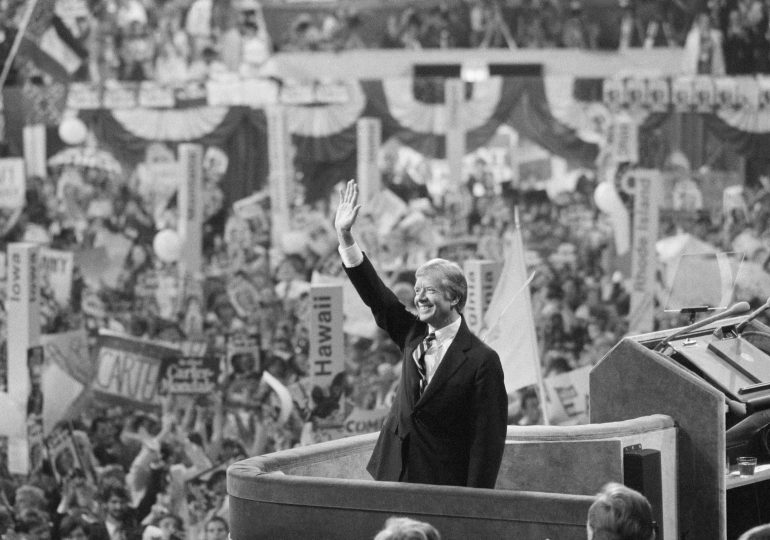In the spring of 1980, I entered the voting booth for the first time. I was a senior in high school, and the Democratic Party was experiencing a heated presidential primary race between incumbent President Jimmy Carter and his challenger, Sen. Ted Kennedy. I was 18 years old, and like so many at that age, I felt I knew it all. I saw Carter as a bumbler who had mismanaged domestic and international affairs. So I cast my ballot for Kennedy.
[time-brightcove not-tgx=”true”]
Though Carter won the 1980 Democratic nomination, on November 4, 1980, he lost his re-election bid to Gov. Ronald Reagan, ending his presidential tenure after a single term. He and First Lady Rosalynn Carter left the White House on January 20, 1981, and returned to their home in Plains, Ga. We didn’t know the phrase at the time, but Carter was, essentially, cancelled.
Read More: Jimmy Carter Was More Successful Than He Got Credit For
The world looks very different today—and so, too, does the man who was turned out of office all those years ago. Five decades later, Carter is viewed as a humanitarian and a statesman; a reputation that eluded him during his 1980 campaign. With Carter’s passing, we should take a moment to reflect on a person who showed incredible grace and grit in a post-presidential life and career. Those of us in the trust building business, in particular, should consider how his status changed so significantly—and what lessons we can learn.
In fact, I’ve found that there are four takeaways from Carter’s reputation restoration:
First, time will reveal the truth. During Carter’s re-election campaign, the President’s inability to free the 52 Americans being held hostage at the American Embassy in Iran became a central issue. His approval ratings plummeted to 31% during the period. Some have since suggested that if the hostages had been released prior to the election, it would have boosted Carter’s reelection prospects— yet the hostages were not released until January 20, 1981, minutes after Reagan’s inauguration. We learned why only recently. In 2023, The New York Times revealed that Reagan ally and Texas political giant John B Connally, Jr., took a private trip to the Middle East during the 1980 campaign with a message for heads of state: Iran would get better treatment from Reagan than Carter, so they should hold the hostages until after the election. That’s exactly what they did, and Carter was denied a victory that might have sent him back to the White House. This revelation certainly reframes history—and recasts Carter’s role.
Read More: Freeing the Hostages Wouldn’t Have Gotten Jimmy Carter Re-Elected
Second, dream new dreams. After they left the White House, the Carters didn’t gaze into the rearview mirror with anger or bitterness. They returned to Georgia and pursued new careers and projects with gusto. They became authors and university professors, and started the Atlanta-based Carter Center—an organization that embodied their shared devotion to humanitarian causes. I’ve been honored to see their work firsthand; my company, Pfizer, has long partnered with The Carter Center to eliminate blinding Trachoma in countries where neglected tropical diseases are endemic. I have had the privilege to visit The Carter Center as well as several treatment sites in Africa where Pfizer and The Carter Center continue to aid those impacted by Trachoma. But my greatest honor was hosting and interviewing President Carter at Pfizer’s headquarters in 2013 to celebrate 15 years of partnership with the International Trachoma Initiative. His warmth, sincerity, intelligence, and charisma were evident to all—and so, too, was the satisfaction he had found in a post-presidential career that allowed him to take on new and vital challenges.
Third, work with your hands. In 1984, shortly after their return to Plains, the Carters launched the Jimmy and Rosalynn Carter Work Project, an annual home-building blitz organized through Habitat for Humanity. The Carters were advocates for affordable housing, but they were also hands-on volunteers. The Work Project wasn’t about galas or red carpets; instead, their construction work kept them busy swinging hammers and driving nails. The Carter Work Project built over 4,400 homes in 14 countries in the 35 years the Carters were directly involved—and allowed the Carters to recreate deep bonds with the public.
Finally, be an optimist—and recognize the opportunity that a new day provides. In Carter’s book, The Virtues of Aging, he writes of a sweeping Barbara Walters interview that covered all aspects of his life. The two spoke about his extensive journey from peanut farmer to submariner; from the Governor’s mansion to the White House, and back home to Plains. At one point, Walters asked him: “Mr. President, you have had a number of exciting and challenging careers; what have been your best years?” Carter’s response was: “Now is the best time of all.”
Read More: A Media Looking for Mistakes Portrayed Jimmy Carter as a Failure. It’s Time to Look Deeper
Let us all take comfort and courage in the former President’s example. Over the course of five decades, he taught us that our best years are not necessarily about the height of our power, but the depths of our resiliency; that history is long, and new opportunities abound. Above all, he taught us that, with the right approach and the right attitude, now can be the best time of all.
President Carter may not have earned my vote as a high schooler in 1980. But nearly five decades later, he has certainly earned my gratitude, admiration, and respect. But most importantly, the life he lived offers lessons for us all.
Leave a comment








